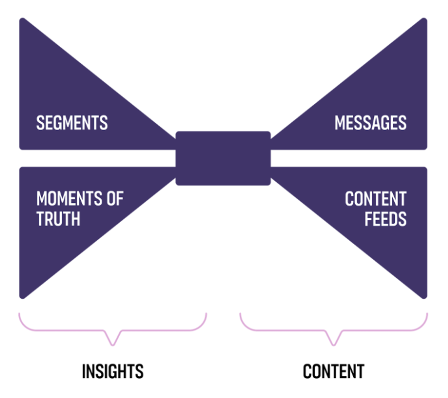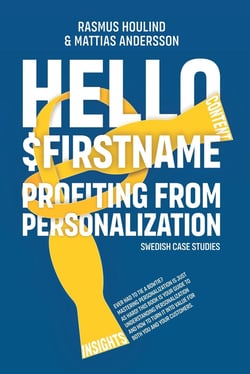The Bowtie of Personalization

In this week’s episode of Datapodden, Rasmus Houlind, CXO at Agillic, discusses his thoughts on personalization and marketing automation. Houlind is the author of Hello $FirstName – a book aimed to provide marketers with a clear understanding of personalization and its implications. During the episode, Houlind highlights several opportunities and challenges associated with the topic.
STATE OF PERMACRISIS
According to Houlind, the world is now in a state of permacrisis. Covid, rising interest rates, the crisis in Ukraine and the Gaza-Israel conflict have resulted in a situation where consumers have less money to spend. Consequently, all consumer-oriented businesses have come under a lot of pressure. From a market perspective, this has incentivized companies to focus more on efficiency and increase their attention on existing customers, repeat business, owned media and first party data.
“Brands should focus on what’s near to their customer relationships. They should make sure they have consent to communicate with their customers and collect their data. This data can then be transformed into insights, which in turn can help them become even more relevant. This is where personalization becomes extra important”, Houlind says.
THE BOWTIE OF PERSONALIZATION
In general terms, personalization is about giving the end customers some kind of treatment that is different from what everybody else is getting, and more aligned with the inferred or explicit preferences of that particular individual. Personalization and marketing automation isn’t necessarily about selling something, it’s about providing an experience that will make it easier for the customer to make the right decision – something that might also be in favor of your business.
These thoughts come together in what Houlind calls “The Bowtie of Personalization”*:

* Source: Hello $FirstName - a book of Rasmus Houlind and Mattias Andersson - click here
The Bowtie of Personalization matches insights and content, which can be seen as two complementing sides joined together by a knot.
On the left-hand side, we have insights, which come in two parts, where segments represent a fairly static group of customers (demographics, value-based- or behavioral sentiments) and moments of truth, which is more about intention and focuses on what the customer is considering right now at this moment. Trying to figure this out can be done through intelligent data collection, preferably in real-time.
These insights should then be matched with your content, which is also divided in two parts. The messages could be CTA’s or anything you want your customer to do, see, feel or know. These messages should be coupled with your content feeds – content that are sourced from somewhere else. This may be an article feed if you you’re a news company, or songs in the case of a company like Spotify. Basically, it’s non-proprietary content that the marketer sorts, divides, ranks etc.
So, these four corners; segments, moments of truth, messages and content feeds, should all come together. From a marketing point of view, it’s about looking at the customer journey and try to figure out how to do it.
“Succeeding with this will not only give you a more frictionless customer experience that may improve conversions statistically, but also a real memorable, pleasurable and personable customer experience where customers feel heard, seen, respected, helped and valued”, according to Houlind.
PERSONALIZATION AND GENERATIVE AI IN MARKETING
Houlind also discusses the red-hot topic of Gen AI in marketing. Gen AI is giving marketers an opportunity to create content, which is the part of personalization that machine learning hasn’t been able to scale.
One of the limiting factors for succeeding with personalization is that we don’t want to spend the resources needed to produce customized content for every end-customer. This obstacle has now, to some degree, been taken out of the equation since you can get at least 80% of the way by having gen AI produce content for a particular message or moment of truth in the customer journey – by prompting it with all the necessary data.
Houlind describes Gen AI as “the self-driving car of marketing”. And much like self-driving cars, we shouldn’t let Gen AI run on full autopilot just yet, we still want to maintain some control to ensure that our communication is in line with how we want our brand to be perceived. But how much control you want may vary between companies.
THE VALUE OF PERSONALIZATION
McKinsey did a study back in 2021 called “Next in Personalization” that revealed that best-in-class companies derived about 40% of their total revenue from personalized communications. Amazing figures, notes Houlind, as most companies would obviously be happy with 15-20% more than they are already making. So, there are substantial financial benefits to be gained.
In general, industries where it’s natural to collect a lot of data points lends themselves well for personalization. Especially if it’s something that people care about. In the old days when electricity was cheap, for example, no one cared about the energy companies, yet they had all the data in the world (household consumption, income, automated meters etc). But along came the energy crisis and suddenly the energy companies were in the sweet spot for being able to deliver personalized customer experiences.
CHALLENGES
The main challenge with personalization is the lack of a common language and understanding of the subject within marketing departments, says Houlind. The book Hello $FirstName was written as an attempt to remedy this. Another overarching issue is that the ambition level isn’t high enough. Sure, companies may buy the tools, but when it comes to human resources – to training and learning – companies are underinvesting. They regard having an email platform as a hygiene factor, for example, but they’re not looking at what they could be really making from it, or what could be accomplished with a sophisticated platform as opposed to a simple one.
“One of the reasons that people don’t invest enough is that they forget to count the money upfront. In other words, you have to sell the pelt before you shoot the bear. It’s about envisioning potential and calculate backwards. After all, if you could grow your customer lifetime value with 30%, that would warrant a pretty substantial investment. Yet companies tend to underinvest when approaching personalization like this”, Houlind concludes.
“Brands should focus on what’s near to their customer relationships. They should make sure they have consent to communicate with their customers and collect their data. This data can then be transformed into insights, which in turn can help them become even more relevant. This is where personalization becomes extra important”
– Rasmus Houlind, CXO at Agillic

Link to the book - Hello $FirstName - clicke here
Would you like to hear more of Rasmus Houlind, don´t miss episode 102 of Data-podden(To be published May 9)


